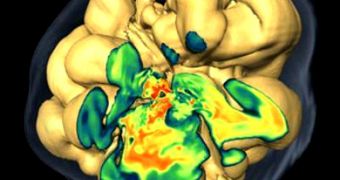When massive stars reach the end of their burning cycle, they tend to blow up in massively large explosions called supernovae. As they do so, they release so much energy that they briefly outshine entire galaxies, featuring billions of stars. Due to the complex nature of the processes involved in such an event, computer simulations could not encompass all aspects of a supernova in a 3D environment.
Physicists therefore had to work with models that only showed certain aspects of these explosions, or only in one or two dimensions. This translates into the fact that, even if computers have been used to simulate these dying stars for several decades, the field of research has been advancing painfully slowly. Now, in a groundbreaking study, a team of German researchers managed to conduct the first-ever 3D simulation of an entire supernova core-collapse event, over a timescale covering several hours. The time was marked when the explosive reaction was first initiated, ScienceDaily reports.
The study, conducted by investigators at the Max Planck Institute for Astrophysics, in Garching, may open the way for a new breed of studies in supernovae. For example, researchers could now be able to determine the exact mechanisms through which matter asymmetries, which develop in the very early stages of the star's explosion, become visible inhomogeneities later on. Two decades ago, astronomers had the chance to look deep within a core-collapse (type II) supernova, when the star SN 1987A, in the Large Magellanic Cloud's Tarantula Nebula, blew up. The initial star was about 20 times more massive than the Sun when it exploded, so researchers could observe it for months.
“With a simple analytic model we could demonstrate that the different geometry of the bullets, toroidal versus quasi-spherical, can explain the differences observed in our simulations. While we think that the differences between the 2D- and 3D-models that we found are probably generic, many features will depend strongly on the structure of the progenitor star, the overall energy and the initial asymmetry of the blast,” MPI expert Thomas Janka, who has also been a coauthor of the new investigation, explains.

 14 DAY TRIAL //
14 DAY TRIAL //